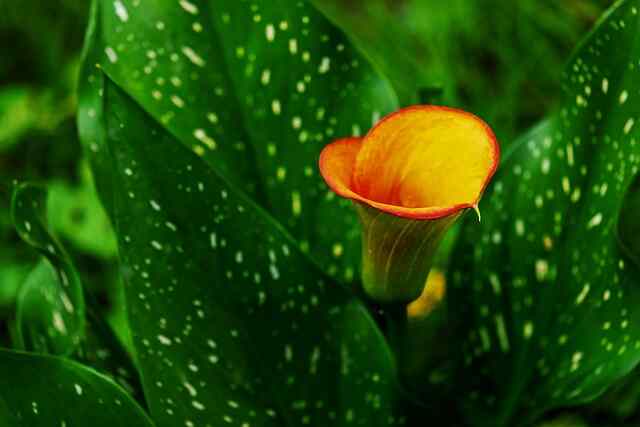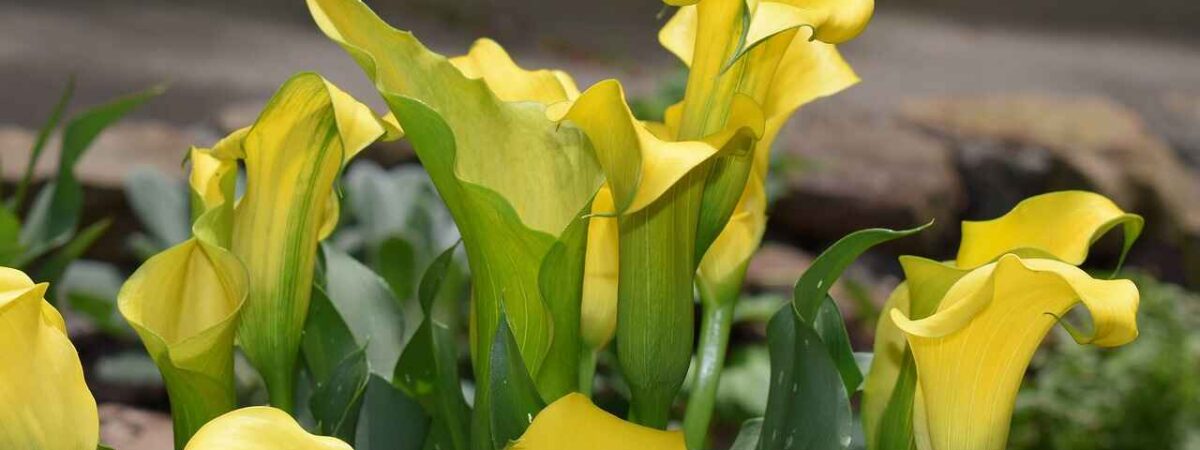Looking to add a touch of elegance to your garden or floral arrangements? Look no further than the beautiful and striking calla lily!
With its trumpet-shaped blooms and glossy, dark green foliage, this plant is a showstopper that is sure to turn heads. But how do you go about growing and caring for calla lilies to ensure that they thrive and produce abundant blooms?
In this blog post, we’ll share all of our top tips and tricks for growing and caring for calla lilies, so you can enjoy their beauty and sophistication year after year.
Whether you’re a seasoned gardener or a beginner, you’re sure to find something useful in this comprehensive guide. So grab your gardening gloves and let’s get started!
Plant Overview
Calla lilies (Zantedeschia aethiopica) are a popular ornamental plant known for their elegant white or colored blooms and attractive foliage. They are native to southern Africa and are also commonly called arum lilies, although they are not true lilies.
The plant has a distinctive funnel-shaped flower that sits atop a tall, leafless stem. The flowers are often white, but can also be found in shades of yellow, pink, and purple. The leaves are large, glossy, and arrow-shaped, and grow from the base of the plant.
These are often used in weddings and other formal events, as well as for cut flower arrangements. They can also be grown as houseplants or in outdoor gardens in suitable climates. However, it’s important to note that all parts of the plant are toxic if ingested, so care should be taken around children and pets.
History and origin of calla lilies

Calla lilies have a long and interesting history, dating back to ancient times. The plant is native to southern Africa but was introduced to other parts of the world through trade and exploration.
In ancient Greek mythology, the calla lily was believed to represent the goddess Hera, the queen of the gods, and was associated with purity and holiness. In Christian tradition, the flower was associated with the Virgin Mary and was often used in religious ceremonies.
During the Victorian era in England, it became a popular flower for weddings and other formal occasions and was seen as a symbol of elegance and sophistication.
In the early 20th century, calla lilies became a popular subject for artists and designers, appearing in paintings, textiles, and other decorative arts.
Today, these flowers have remained a popular ornamental plant, valued for their beauty and versatility. They are grown commercially for the cut flower industry and can be found in a variety of colors, including white, yellow, pink, and purple.
The plant has also been bred to produce larger blooms and more robust foliage, making it a favorite among gardeners and flower enthusiasts.
When and where to plant calla lilies?
The best time to plant calla lilies is in the spring after the threat of frost has passed and the soil has warmed up. This is typically in late March or early April in most regions.
With proper care, calla lilies can bloom for several weeks in the summer, providing a beautiful display of color and texture in your garden.
Calla lilies (Zantedeschia aethiopica) prefer a location that receives partial shade or filtered sunlight, as they can be sensitive to direct sunlight. They also require a moist, well-drained soil that is rich in organic matter.
How to plant calla lilies?
Here are the steps to plant calla lilies:
Choose a location
Select a planting site that has partial shade or filtered sunlight and well-drained soil.
Prepare the soil
Amend the soil with organic matter like compost or well-rotted manure to improve drainage and provide nutrients.
Dig the planting hole
Dig a hole that is about 4-6 inches deep and 6-8 inches wide.
Plant the bulbs
Place the calla lily bulbs in the hole with the pointed end facing up. Space the bulbs about 12-18 inches apart.
Cover with soil
Backfill the hole with soil, gently tamping it down around the bulbs.
Water the area
Water the planting area thoroughly to settle the soil and encourage the bulbs to root.
Mulch the area
Spread a layer of mulch around the planted bulbs to help conserve moisture and suppress weeds.
Care for the plant
Water the calla lilies regularly to keep the soil moist but not soggy. Fertilize the plants every 2-3 weeks during the growing season with a balanced, water-soluble fertilizer. Deadhead spent blooms to encourage continued flowering. After the first frost, cut back the foliage to ground level and cover the planting area with a layer of mulch for winter protection.
With proper planting and care, calla lilies can provide a beautiful display of color and texture in your garden or containers.
How to care for calla lilies?

Water
Calla lilies require consistent moisture to thrive, but they are sensitive to waterlogged soil. It’s important to keep the soil moist but not waterlogged, as this can cause the bulbs to rot.
During the growing season, water your calla lilies deeply once a week, or more frequently during hot, dry weather. Make sure to water the soil around the plant, rather than the leaves, to avoid creating conditions that promote fungal diseases.
It’s also important to avoid letting the soil dry out completely, as this can cause the plant to wilt and the flowers to drop prematurely. Check the soil regularly and water as needed to maintain consistent moisture.
In winter or when the plant is not actively growing, reduce watering to prevent overwatering and root rot. By providing adequate moisture and avoiding waterlogging, you can help ensure that your calla lilies thrive and produce beautiful blooms.
Light
Calla lilies prefer a location that receives partial shade or filtered sunlight, as they can be sensitive to direct sunlight.
In general, calla lilies prefer a location that receives morning or late afternoon sun but is shaded during the hottest part of the day. A spot that receives dappled shade throughout the day is ideal.
If your calla lilies are getting too much sun, the leaves may become bleached or yellowed, and the plant may wilt. If this happens, move the plant to a shadier location or provide shade during the hottest part of the day.
On the other hand, if your calla lilies are not getting enough light, they may produce fewer flowers and the stems may become elongated and weak. If this happens, move the plant to a location that receives more sunlight or provide additional light with a grow light.
By providing the right amount of light, you can help ensure that your calla lilies thrive and produce beautiful blooms.
Temperature
Calla lilies prefer moderate temperatures, typically ranging between 60-75°F (15-24°C) during the day and around 50-55°F (10-13°C) at night.
These plants can be sensitive to extreme heat or cold and may suffer if exposed to temperatures outside of their preferred range. In hot weather, make sure to provide adequate shade and moisture to help keep the plants cool. In colder weather, protect the plants from frost and freezing temperatures.
If temperatures drop below freezing, calla lilies may suffer damage or even die back to the ground. In colder climates, the bulbs may need to be dug up and stored indoors during the winter months to protect them from freezing temperatures.
By providing moderate temperatures and protecting the plants from extreme heat or cold, you can help ensure that your calla lilies thrive and produce beautiful blooms.
Soil
Calla lilies prefer to grow in well-draining soil that is rich in organic matter.
Before planting, prepare the soil by adding compost or aged manure to improve its fertility and structure. Calla lilies prefer soil that is slightly acidic, with a pH between 6.0-6.5. If your soil is very alkaline, you should lower the pH by adding sulfur or peat moss.
It’s important to avoid planting calla lilies in soil that is compacted, heavy or poorly drained, as this can lead to waterlogging and root rot. If your soil is heavy or clayey, consider amending it with sand or perlite to improve drainage.
In containers, use a well-draining potting mix that is specifically formulated for growing flowers or vegetables. Avoid using garden soil or compost, which can be too heavy and may not drain well in containers.
By providing well-draining soil that is rich in organic matter and slightly acidic, you can help ensure that your calla lilies thrive and produce beautiful blooms.
Humidity
Calla lilies prefer moderate to high humidity, but they can tolerate lower humidity levels as well.
If the air is too dry, the leaves may become crispy or wilted, and the flowers may droop prematurely. To increase humidity around your calla lilies, you can mist them regularly with a fine spray of water, or place a humidifier nearby.
Alternatively, you can place your calla lilies on a tray filled with pebbles and water, making sure that the pot is not in direct contact with the water. As the water evaporates, it will create a humid microclimate around the plant.
If you live in a dry climate, you may need to take extra measures to maintain the right humidity level for your calla lilies, such as placing a humidifier in the room or using a humidifying tray.
By providing moderate to high humidity levels, you can help ensure that your calla lilies thrive and produce beautiful blooms.
Fertilizer
Calla lilies benefit from regular fertilization throughout the growing season to encourage healthy growth and abundant flowering.
When planting calla lilies, you can incorporate a slow-release fertilizer into the soil to provide nutrients gradually over time. Alternatively, you can fertilize with a balanced fertilizer (such as a 10-10-10 or 20-20-20) every 4-6 weeks during the growing season (spring to early fall).
It’s important to avoid over-fertilizing calla lilies, as this can lead to excessive foliage growth at the expense of flowers, as well as potential burn to the roots. Follow the manufacturer’s instructions for the recommended amount and frequency of application.
If you notice that your calla lilies are not blooming well, you may need to adjust the fertilizer application or use a fertilizer that is higher in phosphorus, which can encourage flowering.
By providing regular, balanced fertilization, you can help ensure that your calla lilies thrive and produce beautiful blooms.
How to use Calla Lilies in Floral Arrangements?
Calla lilies are popular flowers for use in floral arrangements due to their elegant, trumpet-shaped blooms and long vase life. Here are some tips for using calla lilies in floral arrangements
Choose healthy blooms
Select calla lilies that are in good condition, with no signs of wilting, damage, or disease. Look for blooms with a long stem, as this will make them easier to work with in floral arrangements.
Cut stems at an angle
Use a sharp pair of scissors or floral shears to cut the stems of the calla lilies at a 45-degree angle. This will help them absorb water more easily and prolong their vase life.
Remove lower leaves
Strip any leaves from the stem that will be submerged in water, as this can lead to bacterial growth and shorten the vase life of the flowers.
Combine with other flowers
Calla lilies pair well with a variety of other flowers, including roses, hydrangeas, and tulips. Consider using them in mixed bouquets or arrangements for a beautiful, elegant look.
Add greenery
Incorporate some greenery, such as eucalyptus or ferns, into your floral arrangements to add texture and depth.
Use floral foam
To create a more structured floral arrangement, consider using floral foam as a base. Soak the foam in water before arranging the flowers, and be sure to place the calla lilies at different heights to create visual interest.
By following these tips, you can use calla lilies to create beautiful and elegant floral arrangements for any occasion.
Conclusion

Calla lilies are a popular and beautiful flowering plant that can add elegance and sophistication to any garden or floral arrangement. Calla lilies are relatively easy to care for and can thrive in a variety of growing conditions.
In addition to their use in gardens, calla lilies are also popular for use in floral arrangements due to their long vase life and elegant appearance. They pair well with a variety of other flowers and greenery and can be used to create stunning mixed bouquets or arrangements.
Overall, calla lilies are versatile and beautiful plants that can add color and style to any space. Whether you are growing them in your garden or using them in a floral arrangement, they are sure to make a striking impression.
You may also like to read
How to Grow and Care for Rembrandt Tulips? – A Detailed Guide
Alocasia Plant Love: How to Nurture and Grow These Stunning Plants






